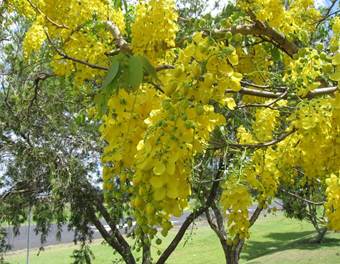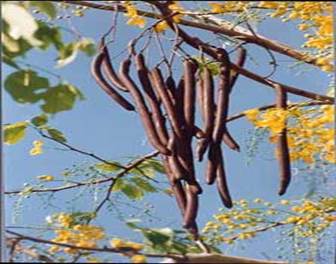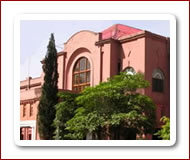| Advisory Services |
Purging Cassia
BOTANICAL NAME:
FAMILY:
- Leguminosae
- Casealpinaceae
SYNONYM(S):
- Cassia rhombifolia Roxb
- Hort
- Beng
URDU NAME:
REGIONAL NAME:
- Bengali: Sundali, Amaltas
- Persian: Khayarshamnbar
- Hindi: Amaltas, Ginimalah
- Pashto: Khals-palay
- Sanskrit: Aragwavadha,Suwamaka,Rajataru
- Arabic: Khayarshamnbar
- Sindhi: Chamkan
- Chinese: A-Pole, Koui Hoa Ts'in,Tch'ang ko chou
UNANI/TIBBI NAME:
ENGLISH NAME:
- Indian laburnum
- Purging cassia
HABITAT:
- A tree commonly planted in gardens throughout Pakistan. Grows in Swat and Hazara eastwards ascending to 4,000 ft
DESCRIPTION:
- A moderate sized 6-10 inch deciduous tree
- Branches slender, pubescent at the extremities
- Leaves upto 45cm long, leaflets 4-8 pairs, ovate bright green above, pale beneath
- Flowers large, scented, bright yellow
- Pods shining dark brown cylindrical pendulous, upto 60cm long and1.5-3 cm in diameter with numerous seeds embedded in black, sweet pulp separated by transverse portion
- Seeds broadly ovate 8mm long 5mm thick
PART USED:
- Fruit pulp
- Root-bark
- Seeds
- Leaves
- Flowers
TASTE:
- Pulp: sweet
- Flowers: Bitter acrid with flavour
- Seeds: sweetish oily
TEMPERAMENT:
PERIOD OF OCCURRENCE:
- The tree flowers from March-June
- The fruit ripens in the cold season
PROCEDURE & TIME OF COLLECTION:
- The pods grow on the tree for most part of the year. They are picked on ripening .The pulp is obtained by heating by the pods and then breaking them open.
CONSTITUENTS:
- Mucilage
- Pectin
- Hydroxymethyl anthraquinone
- Phalobaphenes
- Aloin
- Barbaloin
- Emodien
- Sugar
- Glycosides
- Phenolics
- Proteins
- Resins
- Tannins
- Al3+, Ca2+, Fe2+, Mg2+, K+, Na+
SUBSTITUTES:
- Tranjbeen/Manna (Fraxinusous)
- Tarbad/Terpeth (Operculina turpethum Linn)
ACTIONS AND USES IN UNANI SYSTEM OF MEDICINE:
Pharmacological action:
- Root bark, seeds and leaves: Purgative
- Fruit: Cathartic, Antipyretic, Demulcent
- Flowers: Cooling Effect, Astringent
Therapeutic uses:
- Pulp of the fruit is a safe laxative for children and pregnant women; externally is applied for gout, rheumatism, and snake bite
- Leaves in the form of paste are used are used externally in skin disease
- Bark and leaves, mixed are useful in pustules, ringworm, insect bite, facial paralysis and rheumatism
- Powdered seeds are used for inducing emesis
- Root is useful in fever, biliousness, leprosy, syphilis
DOSES:
CORRECTIVES:
- Mastagi/Mastic(Pistacia Lentiscus Linn)
- Anisoon/Anisi(Pimpinella anisum Linn)
- Roghan-e-Badain/Almond Oil (Prunus ainygdalus Batsch.)
IMPORTANT UNANI FORMULATIONS:
- Laooq Apsis tan khayar Shain.bari
- Majun Kalkalanj
- Laooq Ab Naishakar Wala
- Zimad Sumbul-Ut-Teeb.
ASTROLOGY:
|
|




